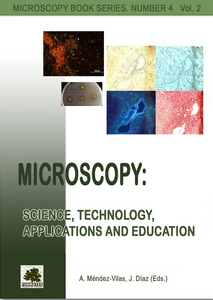A Scanning Probe Microscopy experimental component designed for early graduate/postgraduates students
Watson, J.A., Myhra, S., and Watson, G.S. (2010) A Scanning Probe Microscopy experimental component designed for early graduate/postgraduates students. In: Méndez-Vilas, A., and Diaz, J., (eds.) Microscopy: Science, Technology, Applications and Education. Microscopy Book Series, 2 . Formatex Research Center, Spain, pp. 1327-1337.
|
PDF (Published Version)
- Published Version
Download (1MB) |
||
![[img]](https://researchonline.jcu.edu.au/15399/3.hassmallThumbnailVersion/15399_Watson_et_al_2010_Book_Cover.jpg)
|
Image (JPEG) (Book Cover)
- Cover Image
Download (394kB) |
Abstract
[Extract] The emergence of courses, subjects and dedicated degree programmes in Nanoscience and Nanotechnology has flourished in recent years with an ever growing number of institutions incorporating such components into their undergraduate and more recently graduate/postgraduate programmes.
An important aspect in relation to the study of Nanoscience and Nanotechnology is the emergence of relatively new instruments/techniques such as Scanning Probe Microscope/y (SPM) and particularly Atomic Force Microscopy (AFM). Indeed most general Materials/Surface Science and associated books will now include mention of SPM or present dedicated chapters on this subject reflecting the current and predicted prominence of this form of microscopy. Here we present a laboratory component incorporating a number of key principles and attributes of the SPM system. These can be easily modified to allow addition of new or different aspects related to SPM or simplification for lower level courses or instrumentation with restricted capabilities. The SPM experimental component has been successfully implemented and refined over a 3 year period.
This experimental component includes the following: • Hands on operation and familiarity of a Scanning Probe Microscope instrument. • Fabrication of Micro/Nano structures using SPM lithography (e.g., using a Diamond–Like–Carbon (DLC) film). • Topographical characterisation of the lithographic outcomes. • Fabrication of polymeric structures (e.g., Polydimethylsiloxane) based on the lithographic outcomes (moulds) produced. • AFM characterisation of the fabricated polymer structures in terms of topography, mechanical and adhesive properties and evaluation of the fabrication efficiency from the original lithographic outcomes.
| Item ID: | 15399 |
|---|---|
| Item Type: | Book Chapter (Teaching Material) |
| ISBN: | 978-84-614-6190-5 |
| Keywords: | scanning probe microscopy; atomic force microscopy; education; lithography; nanotechnology; experiment; adhesion; polymer |
| Related URLs: | |
| Additional Information: | Microscopy Book Series - Number 4. Reproduced with permission from Formatex.
|
| Date Deposited: | 12 Apr 2011 00:20 |
| FoR Codes: | 13 EDUCATION > 1303 Specialist Studies in Education > 130309 Learning Sciences @ 100% |
| SEO Codes: | 93 EDUCATION AND TRAINING > 9302 Teaching and Instruction > 930203 Teaching and Instruction Technologies @ 100% |
| Downloads: |
Total: 346 Last 12 Months: 16 |
| More Statistics |



